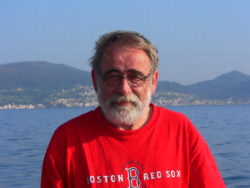Patrick Gentien (1950–2009)

Education
Patrick Gentien was born in Saint-Pol-de-Léon in the French Finisterre, Bretagne, France, on 29 November 1950. He graduated as a chemical engineer from the Hautes Etudes d’Ingénieur (HEI, Lille, 1973) and became a doctor in oceanography from the University of Brest (1977).
Professional Career
From 1980 to 1982 he worked at the Australian Institute of Marine Science (AIMS), where, in collaboration with John Andrews, he described episodic upwelling events on the central Great Barrier Reef. These findings led to a paradigm shift in the understanding of barrier reef nutrient budgets. He then joined IFREMER in 1982 as a researcher in chemistry and hydrobiology at the Environnement Littoral et Gestion du Milieu Marin department. He was director of CREMA-L’Homeau (La Rochelle) from 2000 to 2005, after which he became Head of the Hydrobiology Laboratory at IFREMER Brest.. At the time of his passing he was coordinator of the IFREMER “Oceans and Health” programme.
Honours
Best presentation award at the ICES Annual Science Meeting (Gentien P & Lunven M 1993: New perspectives in coastal marine environment management due to new development in instrumentation. ICES C.M. E:20, 11 pp.). Etymology of Karlodinium gentienii Nézan, Chomérat & Siano
Key HAB contributions
During ecological surveys (1983-1986) in the English Channel he encountered the regionally dominant summer bloom species, Karenia mikimotoi (Gyrodinium aureolum), a major fish-killer in European waters since 1966. His review of the ecology and oceanography of this species was one of his key contributions. Patrick realized early in his career that progress in understanding HAB dynamics required being able to observe them and to measure their properties with the same spatial and temporal resolution applied to measurements of physical processes. With his engineer’s background, his deep knowledge of hydrodynamics and population dynamics, and his fruitful collaboration with Michael Lunven, Patrick passionately pursued the development of sophisticated instruments to detect and measure the in situ properties and behaviour of plankton populations. He was also a pioneer in the identification of allelopathic substances and their potential to explain the mechanisms by which HAB microalgae outcompete co-occurring species. Patrick’s ultimate goal was to describe the physical and chemical microenvironment (the niche) where a determined microalgal populations thrived, in particular when they formed thin layers. One of his passions was to hunt and locate the cryptic, patchy and unpredictable populations of Dinophysis throughout the Bay of Biscay using his high-resolution instruments.
Patrick was deeply involved in international cooperation on HAB research and management. He was the face of France at the ICES-IOC Working Group on HAB Dynamics (Chair 1996–1999), the founding Chair of the Scientific Steering Committee of GEOHAB (Global Ecology and Oceanography of Harmful Algal Blooms; IOC-SCOR, and the IOC Intergovernmental Panel on Harmful Algae Blooms. In all these gatherings Patrick, promoted creative dialogue between “descriptive biologists”, physical oceanographers and. He was able to speak to all of them in their respective ‘‘languages’’ and could reduce intricate discussions on physical–biological interactions into a single question. Wherever he could, he always encouraged people, however young, to develop new ideas. Those of us who worked with him had the opportunity to enjoy his provocative comments and insights, his occasional contrariness, and above all his generosity and willingness to share original ideas to get to the core of scientific problems.
Mentored
François Batifoulier, Sophie Loyer. Whilst within IFREMER, he input to the mentoring of many French postgraduates, as well as international PhD students such as Lourdes Velo-Suárez (Spain) and Hazel Farrell (Ireland). He also strongly influenced many researchers, postdoctoral (Nicolas Chomerat, Sonsoles Gonzales-Gil and Laure Guillou among others) and staff, through his participation in national (DYNECO/PELAGOS) as well as international (HABIT, LIFEHAB, NEMEDA) research programmes.
10 Key publications
Velo Suárez L, González-Gil S, Gentien P, Lunven M, Bechemin C, Fernand L, Raine R, Reguera B. 2008. Thin layers of Pseudo-nitzschia spp. and the fate of Dinophysis acuminata during an upwelling-downwelling cycle in a Galician Ría. Limnology and Oceanography 53, 1816-1834.
Gentien P, Lunven M, Lazure P, Youenou A, Crassous M-P. 2007. Motility and autotoxicity in Karenia mikimotoi (Dinophyceae). Philosophical Transactions of the Royal Society of London. Series B, Biological Sciences 362(1487), 1937-1946. http://archimer.ifremer.fr/doc/00000/2436
Xie H, Lazure P, Gentien P. 2007. Small scale retentive structures and Dinophysis. Journal of Marine Systems 64, 173-188. http://dx.doi.org/10.1016/j.jmarsys.2006.03.008
Guillou L, Nezan E, Cueff V, Denn EEL, Cambon-Bonavita MA, Gentien P, Barbier G. 2002. Genetic diversity and molecular detection of three toxic dinoflagellate genera (Alexandrium, Dinophysis, and Karenia) from French coasts. Protist 153, 223-238. http://dx.doi.org/10.1078/1434-4610-00100
Gentien P. 1998. Bloom dynamics and ecophysiology of the Gymnodinium mikimotoi species complex. In: Anderson DM, Cembella AD, Hallegraeff GM (Eds.), Physiological Ecology of Harmful Algal Blooms, NATO ASI Series G41, Springer-Verlag, Berlin, pp. 155-173.
Parrish CC, Bodennec G, Gentien P. 1998. Haemolytic glycoglycerolipids from Gymnodinium species. Phytochemistry 47, 783-787.
Gentien P, Lunven M, Lehaitre M, Duvent JL. 1995. In-situ depth profiling of particle sizes. Deep-Sea Research Part I 42, 1297-1312.
Lassus P, Arzul G., Erard-Le Denn E, Gentien P, Marcaillou-Le Baut C. (eds.). Harmful marine algal blooms. Lavoisier Publishing Inc., París, 878 pp. ISBN 2-85206-972-5
Gentien P, Arzul G. 1990. Exotoxin production by Gyrodinium cf aureolum (Dinophyceae)
Journal of the Marine Biological Association of the United Kingdom 70, 571-581. http://dx.doi.org/10.1017/S0025315400036596
Andrews JC, Gentien P. 1982. Upwelling as a source of nutrients for the Great Barrier Reef ecosystems: A solution to Darwin's Question? Marine Ecology Progress Series 8, 257-269.
----
Prepared by Beatriz Reguera & Robin Raine

